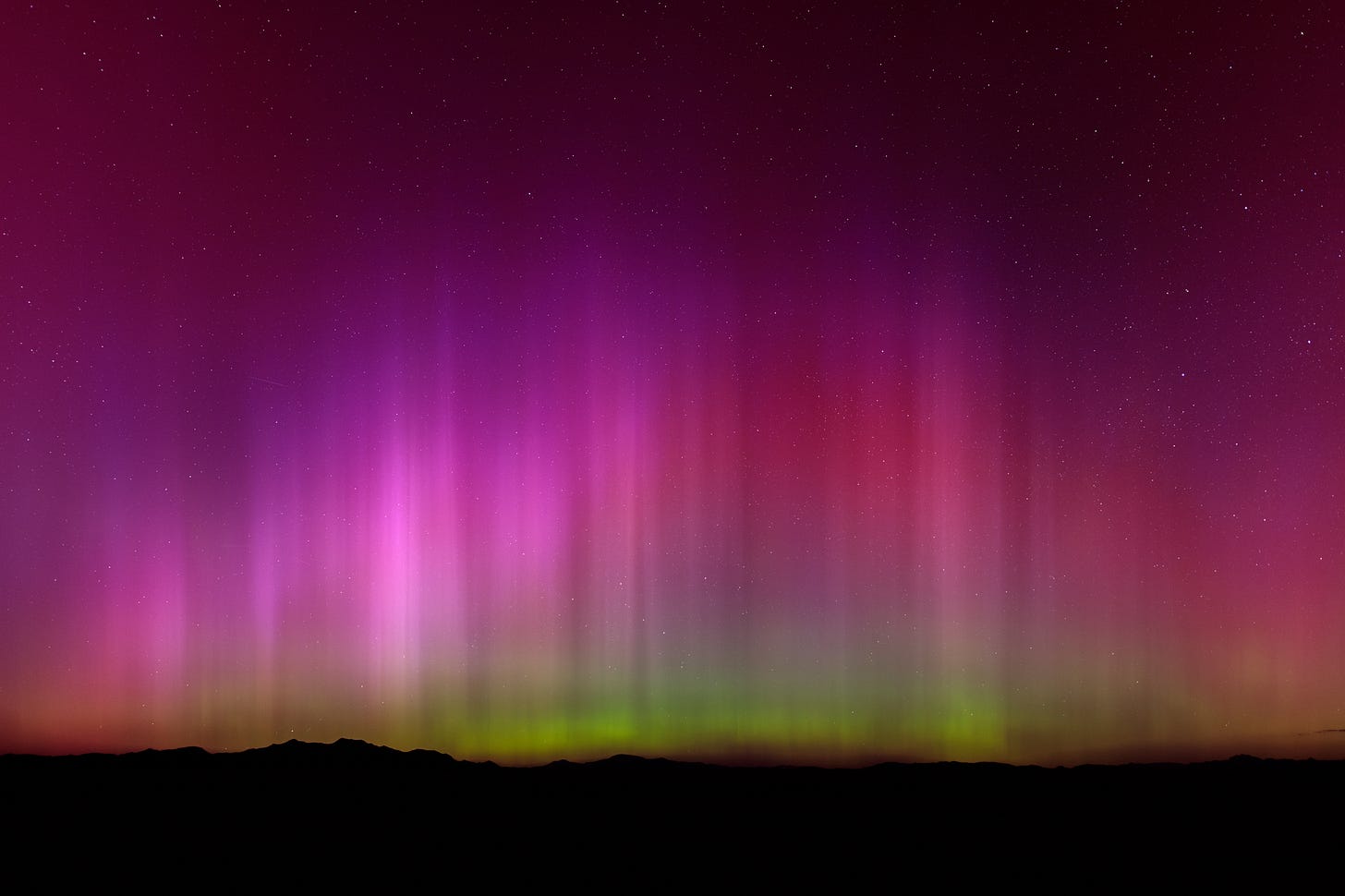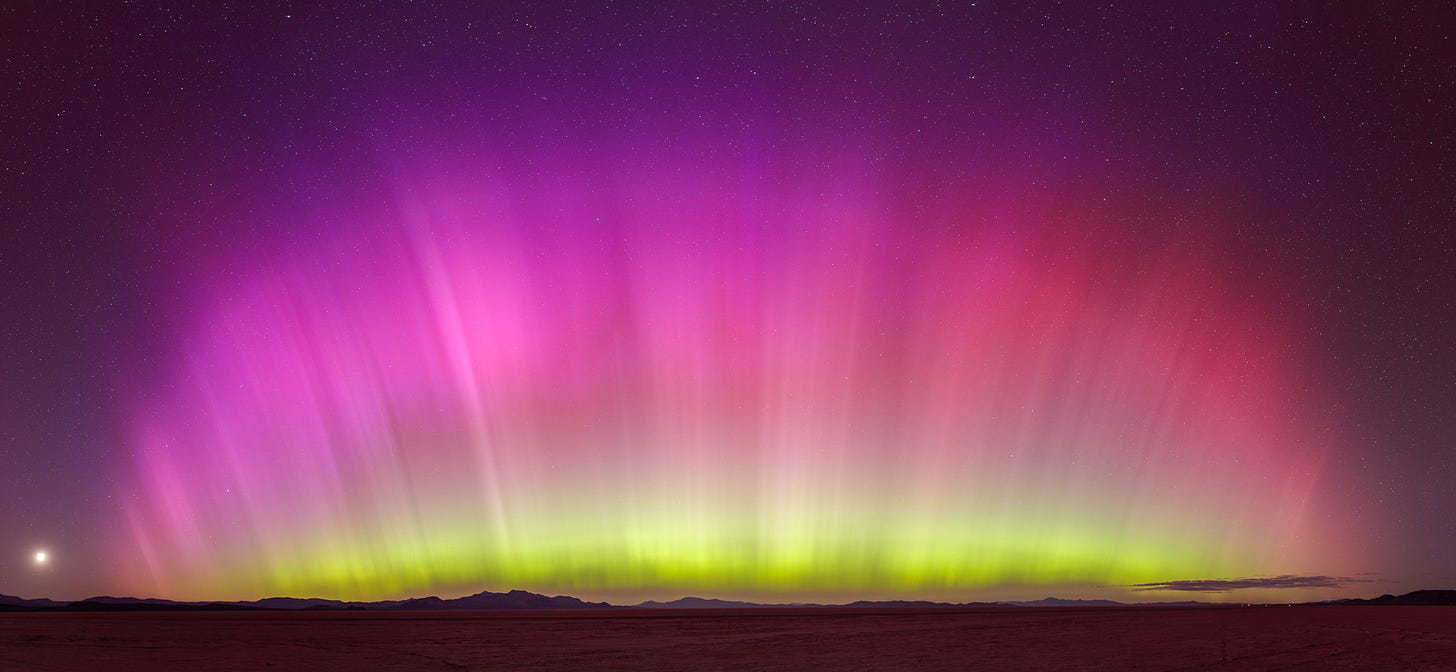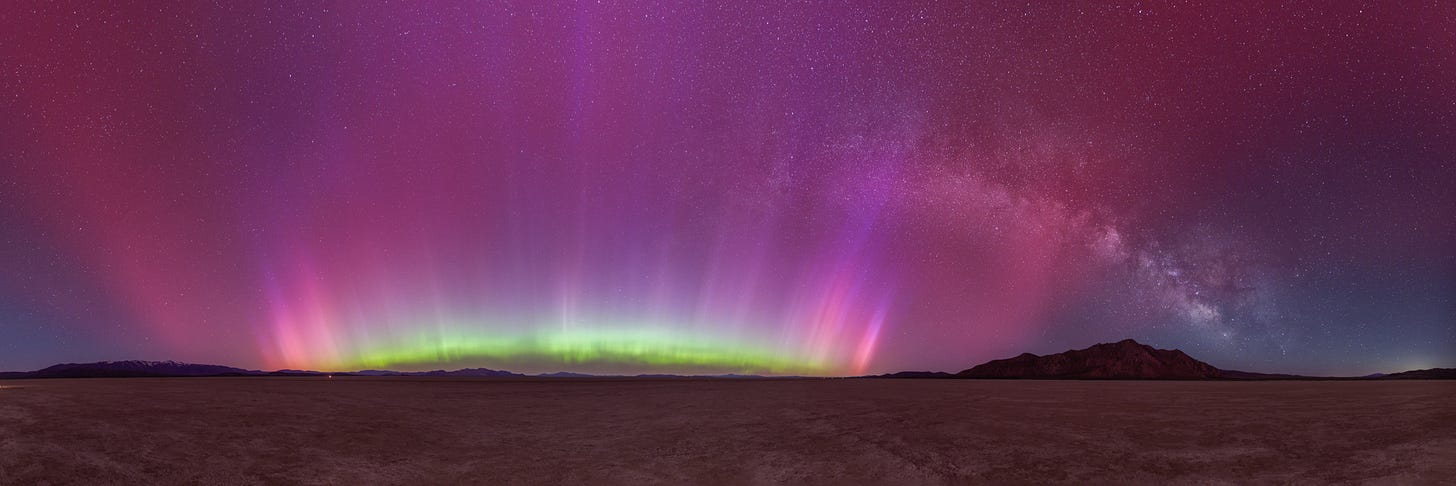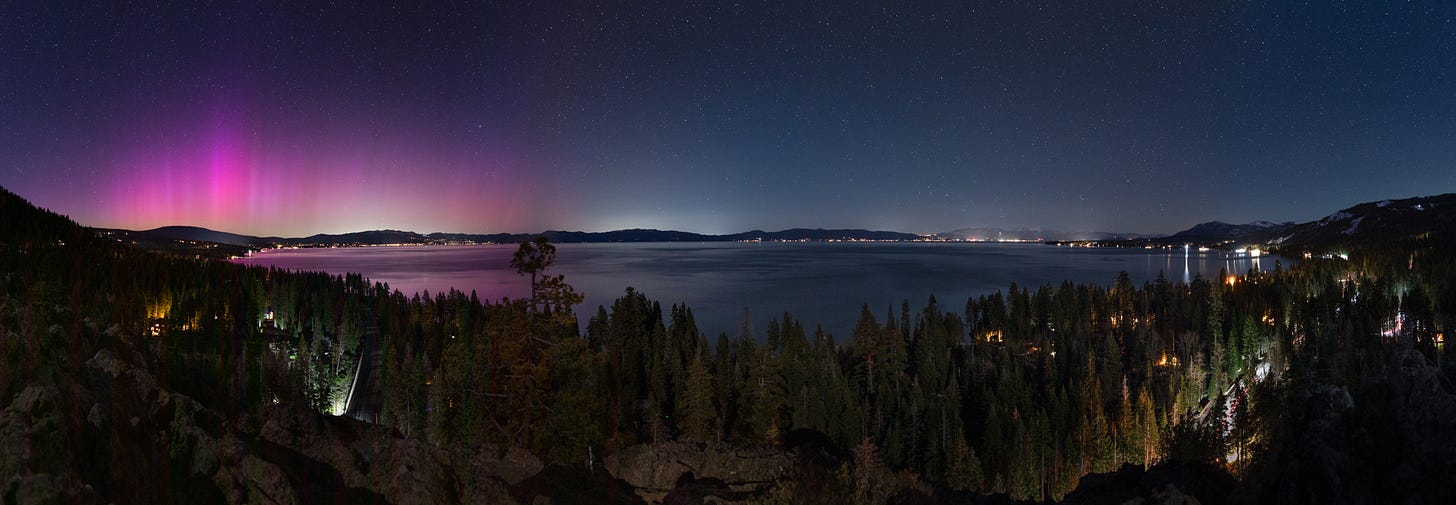Light Show in the Desert: Nevada’s Aurora Experience
Viewing the Extreme Aurora Borealis Displays of May 2024
Foreshadowing
My initial encounter with the aurora in Nevada was on Nov. 4, 2021.
In 2023, Nevada witnessed the aurora on Feb. 27, March 23, April 23, and Nov. 5, marking the busiest year for auroras in the state in two decades.1
Now, in 2024, Nevada experienced its most powerful aurora displays yet on May 10 and 11 in this current cycle.
The ongoing trend of aurora sightings in low latitudes, such as in Nevada, will hopefully continue as solar cycle 25 climbs for its peak next year.

May 9, 2024
On the morning of Thursday, May 9, as I scrolled through Twitter/X, I noticed a buzz in the weather/space community I follow.
The sunspot AR3664, which is about 15 times wider than Earth, had emitted a series of strong flares followed by strong Coronal Mass Ejections (CMEs) that were Earth directed, raising the possibility of low latitude aurora viewing.
The National Oceanic and Atmospheric Administration (NOAA) describes CMEs as ‘a billion tons of plasma ejected from the sun, traveling at a million miles per hour.’
AR3664 is a giant sunspot that was recently compared to the size of the sunspot that caused the 1859 “Carrington Event.”
Realizing these were among the strongest CMEs since 2003, I began preparing for a weekend under the stars.
I adjusted my schedule, notified my fellow stargazing photographers, and prepared for a trip to the dark skies of Northern Nevada.
May 10, 2024
By Friday morning, May 10, the space/weather community could not contain their excitement about what was to arrive later that day. Even the normally conservative forecasts were signaling a powerful storm approaching. There was a lot of anticipation.
I departed Reno at 5:30 p.m. on Friday afternoon, with a few other friends tagging along for the experience.
We arrived at the Black Rock Desert right before sunset, driving across the expansive playa that hosts Burning Man in late summer and remains wonderfully remote and empty the rest of the year.
When planning a trip to the Black Rock Desert, the weather should always be a top priority.
Any wind or intense gusts will cause blowing playa dust, making it an unpleasant experience and decrease visibility to the stars above. Clouds are another factor to consider for visibility. Any rain that occurs turns the playa into a muddy and sticky mess, rendering driving impossible.
This evening had everything weather related aligned perfectly; 2 m.p.h. winds, pleasant temperatures, and 5% cloud cover.
We spent an hour admiring the soft hues of the setting sun and the gradual appearance of the first stars before a peculiar glow captured our attention on the northern horizon.
Initially, we mistook the persistent glow for the last remnants of sunset, only to realize it was the aurora, visible to the naked eye.
I quickly grabbed my camera, already mounted on the tripod, and aimed it at the glowing sight. The results of the colors emanating from the night sky on the back of my camera’s LCD screen blew me away.

I exclaimed, “It’s here already!”
We had previously estimated that the aurora would arrive around midnight while we were still watching the sunset, so for the aurora to be visible as soon as astronomical twilight dwindled and night began, it was a surprise to us all.
From that moment, I was shaking with excitement, yelling into the night sky, and sharing exuberant interactions with my fellow observers, as one does when confronted with the intensity of an aurora display.
With each passing minute into complete darkness, the glow became brighter and even more colors appeared.
I had been to the dark skies of the Black Rock Desert countless times, but this evening under the stars was an entirely new and surreal experience.

The aurora continued all night, and as time passed, the light emanating from the sky would move eastward and then back westward, always holding a steady lock on the north, but traveling back and forth as if it were dancing.
The glowing light would rise and fall toward the zenith (point of the celestial sphere that is vertically above the observer) in the night sky before receding down and shooting back to the zenith again, over and over, until sunrise arrived.
As the pillars of light rose and fell, the colors among them would change effortlessly, as if we were watching a personalized concert of light spreading out over the entire night sky.
To the naked eye, the aurora can be described as different shapes of light within the night sky, mostly of grey and white hues, and sometimes the colors penetrate through to be seen faintly without a camera.
The cameras, however, pick up on extreme colors, most of which aren’t visible to the naked eye.
At one point, the joke amongst the group was whether we needed to be wearing sunscreen or if the plasma radiation would be harmful to us, since it was so intense. The answer is no; it is not harmful and sunscreen is unnecessary.
The overall faint colors painted a purple and pink hue over the desert, creating a truly immersive experience that surrounded our entire visual awareness.

It reminded me of my recent trip to Sphere in Las Vegas to see Phish. The aurora’s shapes mirrored the video displays I saw there. Phish actually used images of the aurora frequently—proving once again that ‘you always end up where you start.’
May 11, 2024
On Saturday, May 11, aurora images from the previous night flooded the internet.
The previous night's storm achieved G5 levels, a level of intensity not witnessed since Oct. 2003.
According to forecasts, Saturday night had the potential to bring the aurora back down to low latitude areas.
News about this spread everywhere, from news stations to social media accounts.
Before heading out again that night, I charged my batteries, napped, and informed interested friends about joining for night two. We chose forests and lakes for the evening’s travels to create a contrast with the desert playas from the previous night.
Upon arrival at Eagle Rock, which overlooks almost the entirety of Lake Tahoe, we noticed it was busier than usual, especially for this time of night. We began the hike up the trail with headlights in tow, prepared for the impending darkness.
At the summit, there were already a few groups set up. Some had serious game time looks on their faces with tripods readied, while others were in a jovial mode celebrating the solar storm watch party.
At approximately 9:25 p.m. the aurora appeared in the northern sky, overlooking the town of Incline Village, Tahoe City, and Kings Beach.

By 9:45 p.m. the sky was dark enough for the aurora to be so pronounced that pillars above the aurora base structure were visible to the naked eye.

At 10:00 p.m. the aurora had mostly faded away, and we weren’t able to spot it again for the rest of the evening.
Following the disappearance of the aurora at the Eagle Rock viewpoint, we hiked down and to try another darker spot 20 minutes north of the lake.
As we traveled along the dark roads at 11:00 p.m. it was apparent that the amount of cars on the roads was significantly more than usual.
Our suspicions about busier highways were confirmed upon reaching Stampede Reservoir. Traffic backed up all along the main road to get into the reservoir and, once there, cars lined up, parked alongside each side road.
Each car with the same idea to get a glimpse of the Northern Lights.
It was unlucky for most who arrived at a dark sky area after 10:00 p.m. as the aurora never showed itself again.
As I’ve learned from my dozens of aurora chases over the past three years, the disappointment of not seeing anything is the most common emotion when trying to find the aurora at this low latitude.
Rarely does it happen, and even rarer does it happen with such intensity as it had the previous night.
Recap and What’s Next
Overall, the weekend’s aurora display was more than I ever expected to experience in Nevada.
The night of May 10 was the strongest solar storm the Earth has encountered since March 1989!
Since I began seeking celestial and cosmic events, the naked eye aurora has always been at the top of my list. Witnessing it without leaving my state makes it even more special.
The images I made over the course of the weekend are currently still being edited. They are also allowing me to study the different structures and colors as I discover them again throughout the editing process. This is carving out a new lane of learning that has been illuminating.
It's possible that I'll revisit certain images from the weekend of May 10 and 11 on this Substack down the line. I'm currently in discussions with a researcher about observing unique aurora structures on the evening of May 10.
Once verified, these topics will be fascinating subjects to discuss…
Chris Wicklund, who is an aurora chaser and all around solid resource, collected the images folks were sending him and created a map plotting out the visibility of such a historic weekend.
The good news for folks who missed this event is that Solar Cycle 25 is expected to reach its peak next year. Assuming the overall trends persist and solar activity remains high, it’s possible to have more frequent aurora sightings at lower latitudes within this time period, so stay tuned.
Also, sunspot AR3664, the culprit for the May 10 and 11 storms, has rotated away from Earth for now, but will return after its 25 day rotation away from Earth. The question will be if the sunspot remains active or has quieted down since we last faced it.
I rely on the NOAA Space Weather Prediction Center website, as well as Twitter/X, for aurora forecasts.
Here are a handful of Twitter/X accounts to follow that communicate aurora forecasting:
Happy aurora viewing!

Well documented solar storms happened on these dates. There may have been more but of a lesser strength.





